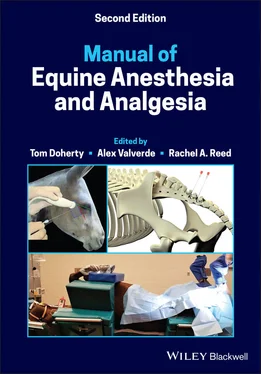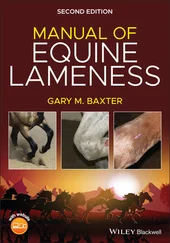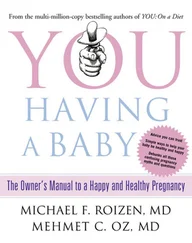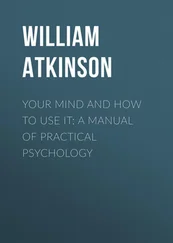1 Cover
2 Title Page
3 Copyright Page
4 List of Contributors
5 Preface
6 Acknowledgments
7 1 Preoperative Evaluation and Patient PreparationThe Risk of Equine Anesthesia Suggested Reading Patient Preparation Suggested Reading
8 2 Serum Chemistry and Hematology Suggested Reading
9 3 The Cardiovascular System Evaluation of the Cardiovascular System Suggested Reading
10 4 The Respiratory System Suggested Reading Physiology of the Respiratory System Suggested Reading Evaluation of the Respiratory System Airway Management Suggested Reading Tracheostomy Suggested Reading
11 5 The Renal System Suggested Reading
12 6 Neurophysiology and Neuroanesthesia Suggested Reading
13 7 The Autonomic Nervous System Suggested Reading
14 8 Electrolyte and Fluid Therapy Suggested Reading Fluid Therapy Suggested Reading
15 9 Acid‐Base Physiology Physicochemical Approach Suggested Reading
16 10 Hemostasis and Hemotherapy Hemotherapy Suggested Reading
17 11 Thermoregulation Suggested Reading
18 12 Pharmacology of Drugs Used in Equine Anesthesia Suggested Reading Butyrophenones Suggested Reading α 2‐Adrenergic Agonists Suggested Reading Opioids Tramadol Suggested Reading Trazadone Suggested Reading Benzodiazepines Suggested Reading Guaifenesin Suggested Reading Ketamine Suggested Reading Tiletamine and Zolazepam (TZ) Suggested Reading Alfaxalone Suggested Reading Propofol Suggested Reading Barbiturates Intravenous lidocaine Suggested Reading Horse‐related drug Regulations in Europe
19 13 Inhalational Anesthetics Suggested Reading
20 14 Local Anesthetics Suggested Reading
21 15 Neuromuscular Blocking Agents in Horses Suggested Reading
22 16 Non‐steroidal Anti‐Inflammatory Drugs and CorticosteroidsNon‐steroidal Anti‐Inflammatory Drugs Corticosteroids Suggested Reading
23 17 Anesthetic Machines and Equipment Suggested Reading
24 18 Positioning the Anesthetized Horse Suggested Reading
25 19 Monitoring the Anesthetized HorseMonitoring the Central Nervous System Suggested Reading Cardiovascular Monitoring Suggested Reading Respiratory Monitoring Suggested Reading Anesthetic Agent Monitoring Monitoring Temperature Suggested Reading Monitoring Neuromuscular Function Suggested Reading
26 20 Standing Sedation
27 21 General Anesthesia Techniques Inhalational Anesthesia Total Intravenous Anesthesia (TIVA) Partial Intravenous Anesthesia (PIVA) Suggested Reading
28 22 Anesthesia of the Head and NeckAnesthesia of the Head Suggested Reading Maxillary Nerve Block in Donkeys Cervical Plexus Block Suggested Reading
29 23 Anesthesia of the Eye Suggested Reading
30 24 Anesthesia of the Limbs Suggested Reading
31 25 Anesthesia of the Perineum and TesticlePudendal Nerve Block – Electrostimulation Technique Pudendal Nerve Block – Blind Approach Local Anesthesia for Castration Suggested Reading
32 26 Anesthesia of the Abdominal WallThoracolumbar Paravertebral Block (TPVB) – Electrostimulation Technique Paravertebral Nerve Block – Blind Technique Transversus Abdominis Plane Block Caudal Intercostal Block for Abdominal Surgery (CIBAS) Suggested Reading
33 27 Epidural Analgesia and Anesthesia Suggested Reading
34 28 Pathophysiology of Pain Suggested Reading
35 29 Pain Recognition in Horses Suggested Reading
36 30 Management of Pain Suggested Reading Rehabilitation Modalities for Acute and Chronic Pain in Horses Suggested Reading Equine Acupuncture Suggested Reading
37 31 Anesthesia of Foals Suggested Reading
38 32 Anesthesia of Horses with Intestinal Emergencies (Colic) Suggested Reading
39 33 Anesthesia of the Geriatric Horse Suggested Reading
40 34 Anesthesia and Pregnancy Suggested Reading
41 35 Anesthesia for Equine Imaging Magnetic resonance imaging Low‐field standing MRI Computed tomography Radiographic myelography Suggested Reading
42 36 Anesthesia of Donkeys and Mules Suggested Reading Sedation and Anesthesia of Donkeys and Mules Suggested Reading Donkey Pain Assessment Scales Suggested Reading
43 37 Remote Capture of Equids Suggested Reading
44 38 Complications Suggested Reading Intraoperative Hypertension Suggested Reading Hypoxia and Hypoxemia Suggested Reading Hypercarbia Suggested Reading Pulmonary Edema as a Consequence of Airway Obstruction Suggested Reading Endotoxemia Suggested Reading Postanesthetic Myopathy Suggested Reading Neuropathy Suggested Reading Hyperkalemic Periodic Paralysis (HYPP) Suggested Reading Malignant Hyperthermia Suggested Reading Delayed Awakening and Recovery Suggested Reading Paraphimosis and Priaprism Suggested Reading Anaphylactic and Anaphylactoid Reactions Anaphylactic reactions Intra‐carotid and Perivascular Injections Equine Cardiopulmonary Resuscitation Suggested Reading
45 39 Recovery from Anesthesia Suggested Reading
46 40 Euthanasia Suggested Reading
47 Index
48 End User License Agreement
1 Chapter 3 Table 3.1 Summary of physiologic laws pertaining to the cardiovascular syste... Table 3.2 Summary of formulas for cardiovascular variables. Table 3.3 Cardiovascular effects of some commonly used anesthetic drugs.
2 Chapter 5 Table 5.1 Site and mechanism of action of diuretics.
3 Chapter 6 Table 6.1 Reported effects of drugs on neurophysiology of the brain.
4 Chapter 7 Table 7.1 Muscarinic receptor subtypes. Table 7.2 Comparative pharmacology of selective β 2adrenergic bronchodilator... Table 7.3 Principal sites of action of adrenergic agonists. Table 7.4 Cardiovascular effects of adrenergic agonists. Table 7.5 Comparative effects of anticholinergic drugs.
5 Chapter 8Table 8.1 Physicochemical characteristics of commonly used intravenous fluid...
6 Chapter 9Table 9.1 Summary of acid‐base disorders.Table 9.2 Acid‐base analysis results for case #1.Table 9.3 Acid‐base analysis results for case #2.
7 Chapter 13Table 13.1 Physicochemical properties of common inhalational anesthetics.Table 13.2 Effect of different injectable agents on MAC in horses.
8 Chapter 14Table 14.1 Classification of nerve fibers and order of blockade.Table 14.2 Physiochemical properties and relative potencies of clinically us...Table 14.3 Clinical indications and doses in horses.
9 Chapter 15Table 15.1 Characteristics of neuromuscular blocking agents commonly used in...Table 15.2 Acetylcholinesterase inhibitors used for reversal of neuromuscula...
10 Chapter 16Table 16.1 Function of the four PGE 2receptor subtypes.Table 16.2 Reported COX ‐1: COX‐2 Selectivity in horses utilizing either IC 5...
11 Chapter 17Table 17.1 Characteristics of varying sizes of oxygen cylinder.
12 Chapter 21Table 21.1 Drugs used for sedation prior to induction of anesthesia. Dosages...Table 21.2 Examples of induction regimens used in equines. Anesthesia should...Table 21.3 Commonly used TIVA protocols in equine practice. Recommended dosa...Table 21.4 Commonly used constant rate infusions for partial intravenous ane...
13 Chapter 28Table 28.1 Diameter, degree of myelination, conduction velocity, and stimulu...
14 Chapter 29Table 29.1 Selected pain scales published and applicable for horses.Table 29.2 Example of the pain scoring sheet used for the equine pain scale ...
15 Chapter 30Table 30.1 Dosages of opioid agents in equine patients.Table 30.2 Dosages and route of administration for alpha 2adrenergic agonist...
16 Chapter 31Table 31.1 Cardiovascular variables in foals of different ages and in the ad...
17 Chapter 34Table 34.1 Physiologic changes identified during pregnancy in women.Table 34.2 Suggested general anesthetic management of a mare with a live foa...
18 Chapter 36Table 36.1 Preparation details – EQUUS donkey composite pain assessment scal...Table 36.2 EQUUS donkey composite pain assessment scale for acute pain.Table 36.3 EQUUS donkey facial assessment of pain scale for acute pain.Table 36.4 Donkey chronic pain – composite pain scale for chronic pain.
Читать дальше












